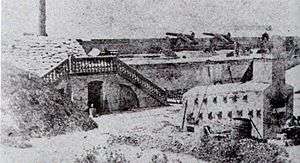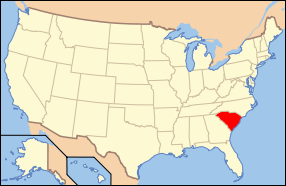Fort Moultrie
| Fort Moultrie | |
|---|---|
| Part of Fort Sumter National Monument | |
| Sullivan's Island, South Carolina, U.S. | |
|
Fort Moultrie in December 2006. The United States flag is at half-staff because of Gerald R. Ford's death. | |
|
Fort Moultrie in 1861. | |
| Coordinates | 32°45′33.81″N 79°51′28.05″W / 32.7593917°N 79.8577917°WCoordinates: 32°45′33.81″N 79°51′28.05″W / 32.7593917°N 79.8577917°W |
| Site information | |
| Owner | National Park Service |
| Open to the public | Yes |
| Site history | |
| Built | 1776 |
| In use | 1776–1947 |
| Battles/wars | Battle of Sullivan's Island |
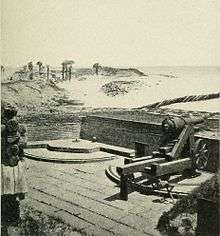
Fort Moultrie is a series of fortifications on Sullivan's Island, South Carolina, built to protect the city of Charleston, South Carolina. The first fort, built of palmetto logs, inspired the flag and nickname of South Carolina, "The Palmetto State". It is named for the commander in the Battle of Sullivan's Island, General William Moultrie.
Fort Moultrie is the only area of the National Park System where the entire 171-year history of American seacoast defense (1776–1947) can be traced.
History
American Revolution
South Carolina patriots began to build a fort to guard Charleston, South Carolina, harbor in 1776. British Admiral Sir Peter Parker with nine British warships attacked the fort—named Fort Sullivan and incomplete—on June 28, 1776, near the beginning of the American Revolutionary War.[1] The soft palmetto logs did not crack under bombardment but rather absorbed the shot; cannonballs reportedly even bounced off the walls of the structure. William Moultrie, commander of the 2nd South Carolina Regiment, and his four hundred men fought a day-long battle that ended with the heavily damaged British ships being driven from the area. This victory galvanized the Patriots' cause for independence.[2] The fort hence took its name Fort Moultrie in his honor. Charleston locals celebrate "Carolina Day" to commemorate the bravery of the defenders of the fort.
During this battle, Moultrie flew a flag of his own design, authorized by the colonial government. It was later called the Moultrie flag or Liberty flag and became iconic to the Revolution in the South.
The British eventually captured Fort Moultrie as part of the Siege of Charleston in spring 1780 and renamed it Fort Arbuthnot.[1] Nevertheless, the colonists won the war, and British troops departed in 1782, at which time the flag was presented in Charleston, by General Nathanael Greene, commander of the southern Regulars.
Early federal period
Great Britain and France began another war in 1793, heightening tensions. The United States of America thence embarked on a significant fortification program for important harbors, later called the First System of fortifications. Atop the decayed original Fort Moultrie, the Army completed a new fort in 1798; the Army also built nineteen other new forts along the Atlantic coast.[3] The fort was garrisoned by Captain Jonathan Robeson's company in 1802. However, after years of neglect the Antigua–Charleston hurricane destroyed Fort Moultrie in 1804.[4]
Fort Moultrie was rebuilt as part of the Second System of fortifications in 1808–09 under the direction of Army engineer Alexander Macomb.[5] A report by the Secretary of War on fortifications in December 1811 describes Fort Moultrie as "an irregular form, built of brick, presenting a battery of three sides on the sea front, and the whole is enclosed with ramparts, parapets, &c. mounting 40 guns. … The barracks are of brick … for five hundred (soldiers)".[2][6]
Fort Moultrie's main design did not change much over the next five decades. The Army altered the parapet and modernized the armament, but defense of Charleston centered increasingly around newly created Fort Sumter. By the time of the American Civil War, Fort Moultrie, Fort Sumter, Fort Johnson, and Castle Pinckney surrounded and defended Charleston.
Fort Moultrie began to record meteorological observations in the early 1820s.
For fifty years the Army detained Native American prisoners at Fort Moultrie. Seminole Indian fighter Osceola and some fellow Seminoles were captured in late 1837 and transferred to the fort. Osceola died of malaria in January 1838; the Army buried his corpse at the front gate of Fort Moultrie and thereafter maintained his grave.
Civil War
In the months leading up to the Civil War John L. Gardner was in command at Fort Moultrie. With secession growing more imminent, Gardner had made several requests to Secretary of War John B. Floyd for more troops to garrison and defend the undermanned fortress. Each time his requests were ignored, as Floyd (who joined the Confederacy) was planning to hand the forts in Charleston Harbor over to the secessionists.
South Carolina seceded from the Union on December 20, 1860. Around this time a Federal garrison from the 1st US Artillery was sent to Fort Moultrie. Unlike the state militia at the other forts, the Regular Army defenders of Fort Moultrie chose not to surrender to the South Carolina forces. On December 26, 1860, Union Major Robert Anderson moved his garrison from Fort Moultrie to the stronger Fort Sumter. On February 8, 1861, South Carolina joined other seceded Deep Southern states to form the Confederate States of America. In April 1861, Confederate troops shelled Fort Sumter into submission and the American Civil War began.
In April 1863, Federal ironclads and shore batteries began a bombardment of Fort Moultrie and the other forts around Charleston harbor. Over the ensuing twenty months, Union bombardment reduced Fort Sumter to a rubble pile and pounded Fort Moultrie below a sand hill, which protected it against further bombardment. The Rifled cannon proved its superiority to brickwork fortifications but not to the endurance of the Confederate artillerymen who continued to man Fort Moultrie. In February 1865, the Confederate Army finally abandoned the rubble of Fort Moultrie and evacuated the city of Charleston.
Postbellum period and 20th century
The Army modernized Fort Moultrie in the 1870s with new weapons and deep concrete bunkers. Weapons of this period included 15-inch and 10-inch Rodman guns, which were smoothbores, and 8-inch converted rifles, lined down from 10-inch Rodmans.
Beginning in 1897, Fort Moultrie's armament was modernized under the large-scale Endicott Program of coast defenses. Eight new reinforced-concrete batteries were completed by 1906, and part of the Second System fort was demolished to make room for batteries Bingham, McCorkle, and Lord.[7][8] The fort also had a mine casemate to control a naval minefield.[1] In 1901 Coast Artillery units were designated from heavy artillery units, and in 1907 the United States Army Coast Artillery Corps was formed to garrison the new coast defenses.[9]
The Endicott Program batteries at Fort Moultrie were:[7][8]
| Name | No. of guns | Gun type | Carriage type | Years active |
|---|---|---|---|---|
| Capron-Butler | 16 | 12-inch mortar M1886 | barbette M1891 | 1898–1942 |
| Jasper | 4 | 10-inch gun M1888 | disappearing M1896 | 1898–1942 |
| Thompson | 2 | 10-inch gun M1900 | disappearing M1901 | 1906–1945 |
| Gadsden | 4 | 6-inch gun M1903 | disappearing M1903 | 1906–1917 |
| Logan | 1 | 6-inch Armstrong gun | pedestal | 1899–1904 |
| Logan | 1 | 6-inch gun M1897 | disappearing M1898 | 1899–1944 |
| Bingham | 2 | 4.72-inch 45 caliber Armstrong gun | pedestal | 1899–1919 |
| McCorkle | 3 | 3-inch gun M1898 | masking parapet M1898 | 1901–1920 |
| Lord | 2 | 3-inch M1902 seacoast gun | pedestal M1902 | 1905–1946 |
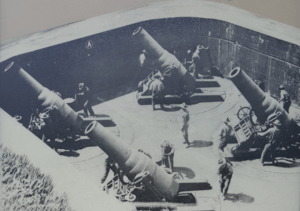
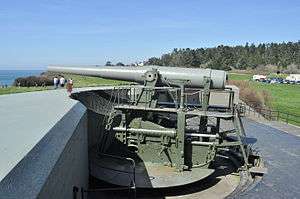
Battery Capron, with sixteen 12-inch mortars, was the largest component of the new defenses. In 1906 it was organizationally split into two batteries, Capron and Butler, each with eight mortars. Batteries Jasper and Thompson provided longer-range weapons with a total of six 10-inch disappearing guns.[7][8] In April 1898 the Spanish–American War broke out, with Fort Moultrie's smaller, rapid-fire batteries still years from completion. Batteries Logan and Bingham were added to the fort, mostly equipped with weapons purchased from the United Kingdom.[10] In 1901 Battery McCorkle was added to defend the minefield against minesweepers with three 3-inch guns on retractable masking parapet carriages. In 1905 Battery Lord was added with two 3-inch guns, and in 1906 Battery Gadsden provided four 6-inch rapid-fire disappearing guns.[7][8]
These batteries were supplemented in 1899 by a pair of 12-inch guns at Fort Sumter. Forts Moultrie and Sumter constituted the Coast Defenses of Charleston, as the Charleston Coast Artillery District was designated in 1913.[8][11][12][13]
Battery Capron was named for Captain Allyn K. Capron of the 1st US Volunteer Cavalry, the famous "Rough Riders", who was the first US Army officer killed in the Spanish–American War. Battery Butler was named for Colonel Pierce M. Butler of the Palmetto Regiment, killed in the Battle of Churubusco in the 1847 Mexican–American War. Battery Jasper was named for Sergeant William Jasper of the 2nd South Carolina Regiment, a hero of the 1776 attack on the fort. Battery Thompson was named for Colonel William Thompson of the 3rd South Carolina Regiment, commended for defending Charleston in June 1776. Battery Gadsden was named for Brigadier General Christopher Gadsden, a South Carolina officer of the Revolutionary War. Battery Logan was named for Captain William Logan, killed fighting the Nez Perce in 1877. Battery Bingham was named for 2nd Lieutenant Horatio Bingham, killed fighting the Sioux in 1866. Battery McCorkle was named for 1st Lieutenant Henry McCorkle of the 25th US Infantry Regiment, killed in the Battle of El Caney in the Spanish–American War. Battery Lord was named for Assistant Surgeon George Edwin Lord, killed at the Battle of the Little Big Horn, also called "Custer's Last Stand", in 1876.[7]
In 1904 Battery Logan's 6-inch Armstrong gun was removed and most likely transferred to Fort Adams.[7][8]
After the US entered World War I, Battery Gadsden's four 6-inch guns were removed for service on field carriages on the Western Front in 1917 and were never returned to the fort.[7] Records show the guns arrived in France, but a history of the Coast Artillery in World War I states that none of the regiments in France equipped with 6-inch guns completed training in time to see action before the Armistice.[14]
Two of Battery Jasper's four 10-inch guns were similarly removed in 1918 for potential use as railway guns; they were never returned to the fort but were replaced with guns from Fort Washington in 1919.[7]
Following World War I there were several changes at Fort Moultrie as part of a forcewide partial disarmament of the coast defense system. Battery Bingham's two 4.7-inch Armstrong guns and Battery McCorkle's three 3-inch M1898 guns were removed in 1919–20 as part of a general removal from service of some gun types. Eight of Battery Capron-Butler's mortars were removed and the remaining eight replaced with M1890 mortars on M1896 carriages in 1920. The removal of half the mortars was a forcewide measure to increase the rate of fire by reducing overcrowding of mortar pits during reloading.[7][8]
With the outbreak of World War II in 1939 and the Fall of France in 1940, a comprehensive upgrade of US coastal fortifications was implemented. In the early part of the war the Harbor Defenses of Charleston were garrisoned by the 13th Coast Artillery Regiment of the Regular Army and the 263rd Coast Artillery Regiment of the South Carolina National Guard.[15] The Marshall Military Reservation, a sub-post of Fort Moultrie, was established in the northeast part of Sullivan's Island to accommodate the new batteries. The batteries built during World War II at and near Fort Moultrie were:[7][8]
- BCN = Battery Construction Number
- AMTB = Anti-Motor Torpedo Boat Battery
| Name | No. of guns | Gun type | Carriage type | Years active |
|---|---|---|---|---|
| BCN 520 | 2 | 12-inch gun M1895 | long-range barbette M1917 | 1944–1947 |
| BCN 230 | 2 | 6-inch gun M1 | shielded barbette M4 | Not armed |
| unnamed | 4 | 155 mm gun M1918 | towed with Panama mounts | 1941–1945 |
| AMTB 2A | 4 | 90 mm gun | two fixed T2/M1, two towed | 1943–1946 |
Additionally, a battery of two 16-inch guns designated BCN 125 was proposed for James Island, south of Charleston Harbor, but was never built.[8]
The unnamed battery of four 155 mm M1918 towed guns on concrete Panama mounts was established in 1941 to quickly augment Charleston's harbor defenses.[16]
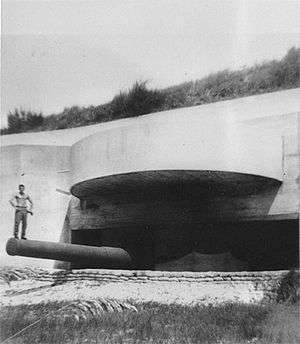
The construction of the long-range BCN 520 with 12-inch guns rendered all previous gun defenses in the Charleston area obsolete. BCN 520 was armed with guns removed from Battery Kimble at Fort Travis, Galveston, Texas.[16] Almost all of Fort Moultrie's previous armament was scrapped in 1942, except Battery Thompson's pair of 10-inch guns and Battery Lord's pair of 3-inch guns. The two fixed emplacements of AMTB 2A were built on the former 10-inch Battery Jasper. A Harbor Entrance Control Post (HECP) to coordinate Army and Navy harbor defenses was established at the old fort and has been refurbished as an exhibit.[7][8]
On August 15, 1947, the Army lowered Fort Moultrie's flag for the last time and ended 171 years of service. After the war, due to changes in military technology, including submarines and nuclear weapons, seacoast defense of the United States ceased to be a viable strategy.
Decommissioning
|
Fort Moultrie Quartermaster and Support Facilities Historic District | |
|
The former torpedo (naval mine) storage building at Fort Moultrie; today it serves as office space for the park. | |
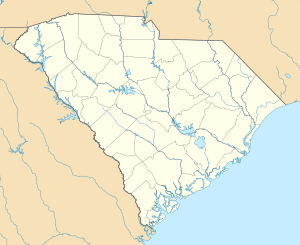  | |
| Location | Middle St. and Thompson Ave., bet. Stations 14 and 16.5, Sullivan's Island, South Carolina |
|---|---|
| Area | 5.3 acres (2.1 ha) |
| MPS | Sullivan's Island, South Island MPS |
| NRHP Reference # | 07000925[17] |
| Added to NRHP | September 6, 2007 |
In 1960, the Department of Defense transferred Fort Moultrie to the National Park Service. NPS manages the historic fort as a unit of Fort Sumter National Monument.[18] NPS has interpreted the fort as a tour backward in time from its defenses from World War II to the original palmetto log fort constructed by William Moultrie. The preserved Harbor Entrance Control Post and BCN 520 (now a private residence) are the main relics of the World War II era.
The National Register of Historic Places listed Fort Moultrie Quartermaster and Support Facilities Historic District on September 6, 2007.[19][20] In 2016, the "America the Beautiful" quarter for South Carolina will feature "Fort Moultrie (Fort Sumter National Monument)."
Moultrie is honored with his statue in The Battery section of downtown Charleston.
See also
Bibliography
- Berhow, Mark A., Ed. (2015). American Seacoast Defenses, A Reference Guide, Third Edition. McLean, Virginia: CDSG Press. ISBN 978-0-9748167-3-9.
- Detzer, David (2002). Allegiance: Fort Sumter, Charleston, and the Beginning of the Civil War.
Houghton Mifflin Harcourt. p. 400. ISBN 9780156007412., Book (par view) - Doubleday, Abner (1998). Reminiscences of Forts Sumter and Moultrie in 1860-61. Charleston, SC: Nautical & Aviation Publishing Company. ISBN 1-877853-40-2.
- Lewis, Emanuel Raymond (1979). Seacoast Fortifications of the United States. Annapolis: Leeward Publications. ISBN 978-0-929521-11-4.
- Lossing, Benson John (1874). The Pictorial Field Book of the Civil War in the United States of America, Volume 1.
Hartford: Thomas Belknap. p. 640., E'book - Moore, Frank (1889). The Civil War in Song and Story, 1860–1865.
New York: P. F. Collier. p. 560., E'book - Rinaldi, Richard A. (2004). The U. S. Army in World War I: Orders of Battle. General Data LLC. ISBN 0-9720296-4-8.
- Wade, Arthur P. (2011). Artillerists and Engineers: The Beginnings of American Seacoast Fortifications, 1794-1815. McLean, Virginia: CDSG Press. ISBN 978-0-9748167-2-2.
- Wilson, James Grant; Fiske, John (1888). Appleton's Cyclopaedia of American Biography, Volume 2.
D. Appleton and Company, New York., E'book
References
- 1 2 3 Fort Moultrie at NorthAmericanForts.com
- 1 2 Fort Moultrie brochure, United States Department of the Interior, National Park Service
- ↑ Wade, pp. 59–60
- ↑ Wade, pp. 88, 106
- ↑ Wade, p. 154
- ↑ Wade, p. 245
- 1 2 3 4 5 6 7 8 9 10 11 Fort Moultrie article at FortWiki
- 1 2 3 4 5 6 7 8 9 10 Berhow, p. 213
- ↑ Berhow, pp. 423-427
- ↑ Congressional serial set, 1900, Report of the Commission on the Conduct of the War with Spain, Vol. 7, pp. 3778–3780, Washington: Government Printing Office
- ↑ Fort Sumter article at FortWiki
- ↑ Coast Artillery Organization: A Brief Overview at the Coast Defense Study Group website
- ↑ Rinaldi, pp. 165-166
- ↑ History of the Coast Artillery Corps in WWI
- ↑ Stanton, Shelby L. (1991). World War II Order of Battle. Galahad Books. pp. 456, 472, 478. ISBN 0-88365-775-9.
- 1 2 Marshall Military Reservation article at FortWiki.com
- ↑ National Park Service (2010-07-09). "National Register Information System". National Register of Historic Places. National Park Service.
- ↑ National Park Service. "Fort Sumter National Monument Draft GMP/EA" (PDF). Retrieved 2010-06-25. "The National Park Service accepted jurisdiction of Fort Moultrie in 1960 under authority of the Historic Sites Act of 1935 Pub.L. 74–292.", p.9.
- ↑ Schneider, David B. (March 6, 2007). "Fort Moultrie Quartermaster and Support Facilities Historic District" (pdf). National Register of Historic Places - Nomination and Inventory. Retrieved 10 June 2012.
- ↑ "Fort Moultrie Quartermaster and Support Facilities Historic District, Charleston County (Sullivan's Island)". National Register Properties in South Carolina. South Carolina Department of Archives and History. Retrieved 10 June 2012.
External links
| Wikimedia Commons has media related to Fort Moultrie National Monument. |
- Fort Moultrie
- Historic Charleston's Religious and Community Buildings, a National Park Service Discover Our Shared Heritage Travel Itinerary
- Fort Moultrie at USForting.com
